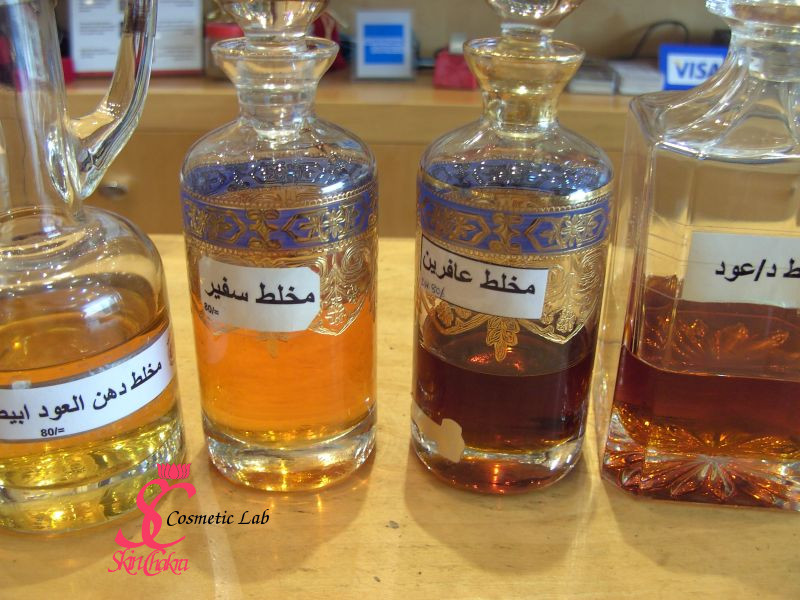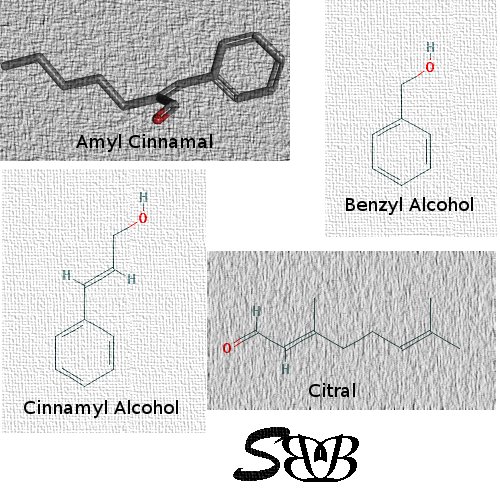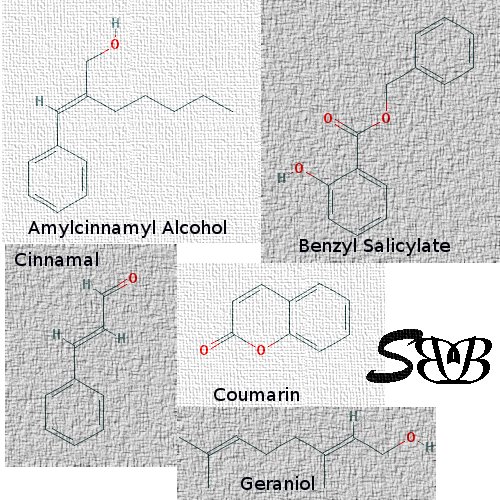
EU Commission Publishes SCCS’s Opinion on Fragrance Allergens in Cosmetic Products
End of July, the SCCP (Scientific Committee on Consumer Products) has released an updated list of fragrance allergens.
We are all accustomed with that famous list with 26 fragrance allergens. Now in a report published end of July, the SCCP has confirmed that that listing is still relevant and had expanded that list to 54 individual chemicals and 28 plant extracts.
In 1999, the European Scientific Committee SCCNFP identified 26 fragrance allergens. It is estimated that 1-3% of the European population is affected by an allergy to fragrance ingredients.
Since March 2005 these ingredients should be listed on the label if their total concentration in the product is over 10 ppm (0,001%) in Leave-On Products and over 100 ppm (0,01%) in Rinse-Off Products. Detergents and home care products are as well under this labeling act since 08.10.2005 (EG) Nr.648/2004.
The existing list of fragrance allergens
The existing list contains 24 individual chemicals and 2 plant extracts, from which 13 are also found in many natural essential oils.
These are:
1-Amyl Cinnamal
CAS# 122-40-7 EINECS#204-541-5
Amyl Cinnamal, known as well as Jasminal or Jasminaldehyde is present in soybean or black tea but it is mainly prepared synthetically for perfumery. From a chemical point of view, it is an Aldehyde. It has a sweet floral note and is applied e.g. in almond, apple, apricot scents. It was applied in Anais Anais and Chanel#5.
2-Benzyl Alcohol
CAS# 100-51-6 EINECS#202-859-9
Benzyl alcohol is a solvent and an important ingredient in perfumery and pharmacy . It is present in many natural essential oils such as clove oil, Jasmin absolut, rose absolut and Ylang-Ylang. It is an aromatic alcohol also called Phenylmethanol.
3- Cinnamyl Alcohol
CAS# 104-54-1 EINECS#203-212-3
Cinnamyl alcohol (a monoterpenol) also called Cinnamic alcohol or Zimtalcohol is present in Cinnamon, Peru balsam and Styrax with a sweet balsamic note. It was used in Amour Amour and in Cinq Fleur forvil.
4- Citral
CAS# 5392-40-5 EINECS#226-394-6
Citral called as well Geranial is a monoterpene aldehyde and is present in Litsea cubeba, Lemongrass, Bergamot, cardamom, Grapefruit, Petitgrain and Ginger. It has a citrus note.

5- Eugenol
CAS# 97-53-0 EINECS#202-589-1
Eugenol is a phenol and is available in oils of Clove, Jasmin, Basil, Cinnamom and Pepper. It has a sweet spicy note.
6- Hydroxycitronellal
CAS# 107-75-5 EINECS#203-518-7
Is an aldehyde with a floral note. It is prepared synthetically and is not avilable in nature. Is was used in
Charlie, Cinq Fleur forvil, Chanel#5.
7-Isoeugenol
CAS# 97-54-1 EINECS#202-590-7
Isoeugenol is a phenol with a spicy note and is present in clove oil, nutmeg and Ylang-Ylang.

8-Amylcinnamylalcohol
CAS# 101-85-9 EINECS#202-982-8
It is prepared synthetically and has a spicy note.
9-Benzyl salicylate
CAS# 118-58-1 EINECS#204-262-9
It is an aromatic ester with a spicy note and is present in Ylang-Ylang oil as an example. It was applied in anais anais, amour-amour and l'air du temps.
10- Cinnamal
CAS# 104-55-2 EINECS#203-213-9
Cinnamal also known as Zimtaldehyde or Cinnamaldehyde is an aromatic aldehyde and is present in essential oils of cinnamom, cassia and Patchouli. It has a spicy note.
11-Coumarin
CAS# 91-64-5 EINECS#202-086-7
Belongs to the coumarin family. Is present in oils of cinnamom, lavernder, peppermint and tonka.
12- Geraniol
CAS# 106-24-1 EINECS#203-377-1
Also known as Nerol, Neryl Alcohol or Geranyl Alcohol. It is a Monoterpenol and is present in apple juice, blueberry, Bergamot, cardamom, laurel, coriander, carrot seed, Rose, Geranium, Ylang-Ylang and Palmarosa.

13- Hydroxyisohexyl 3-cyclohexene carboxaldehyde
CAS# 31906-04-4 EINECS#250-863-4
It is prepared synthetically and has a floral note.
14- Anisyl Alcohol
CAS# 105-13-5 EINECS#203-273-6
Also called anisic alcohol or anise alcohol. It has a sweet creamy note and is available in small concentrations in many essential oils.
15- Benzyl Cinnamate
CAS# 103-41-3 EINECS#203-109-3
It has a balsamicspicy note and is present in peru balsam, styrax, Ylang-Ylang. It is an aromatic ester.
16- Farnesol
CAS# 4602-84-0 EINECS#225-004-1
Known as well as farnesyl alcohol, it has a floral note and is an sesquiterpene. It is present in Plamarosa, Ylang-Ylang, Neroli, Geranium, Citronella, Thyme and in Cranberry, Wine or turmeric.
17- Butylphenyl Methylpropional
CAS# 80-54-6 EINECS#201-289-8
Also called Lilyall, it is prepared synthetically and has a floral note. It is applied for example in Coconut tropical, Grapefruit, Fern fougere, Muguet Lily of the valley.

18- Linalool
CAS# 78-70-6 EINECS#201-134-4
It is a monoterpenol and is present in many essential oils: lavender, basil, coriander, ylang-ylang, bergamot, blood orange, rose wood, cardamom, cinnamom, carrot seed as well as in cranberry, apricot and apple juice.
19- Benzyl Benzoate
CAS# 120-51-4 EINECS#204-402-9
Benzyl benzoate is an aromatic ester with a balsamic note. It is present in Jasmin Absolut, Rose wood, clove and Ylang-Ylang.
20- Citronellol
CAS# 106-22-9 EINECS#203-357-0
It is a monoterpenol with a sweet floral note. Citronellol is a part of oils of Citronella, Bergamot, eucalyptus, cardamom and Litsea cubeba.
21- Hexyl Cinnamal
CAS# 101-86-0 EINECS#202-983-3
It is prepared synthetically and has a floral note. It was applied in Charlie, l'air du temps, Florida breeze.
22-Limonene
CAS# 5989-27-5 EINECS#227-813-5
Known as well as carvene, Citrene, dextro Limonene, d-Limonene, R-Limonene. It is a Monoterpene with citrus note and is present as a major ingredient in essential oils of the citrus family: Lemon, Neroli, Bitterorange, Grapefruit as well as in tea tree oil, pepper or nutmeg.
23- Methyl 2-Octynoate
CAS# 111-12-6 EINECS#203-836-6
Is synthetically prepared, has a green note and was applied in Frangipanni plumeria.
24-Alpha-Isomethyl Ionone
CAS# 127-51-5 EINECS#204-846-3
Is synthetically prepared, has a floral note and was applied in Charlie or l'air du temps.
25-Evernia Prunastri
CAS# 90028-68-5 EINECS#289-861-3
Is better known as Oakmoss Extract.

26- Evernia Furfuracea
CAS# 90028-67-4 EINECS#289-860-8
Is better known as Treemoss Extract.
The update
Please note that we are talking about a report of the SCCP. It will take years till a new restriction is called in force. At the moment you've to list only the above 26 ingredients in your products.
It is reasonable to read the whole report (look at the link in reference list). If you however do not have enough time or motivation to read the whole report (over 300 pages), Irecommend to have a look at the ingredients which are suggested as potential allergens.(Pages 45-55)
References:
Perfumer & Flavorist
The actual list of fragrance allergens as PDF
The complete report
Swettis Beauty Blog am : Meet the Fragrance (and Essential Oil) Allergens